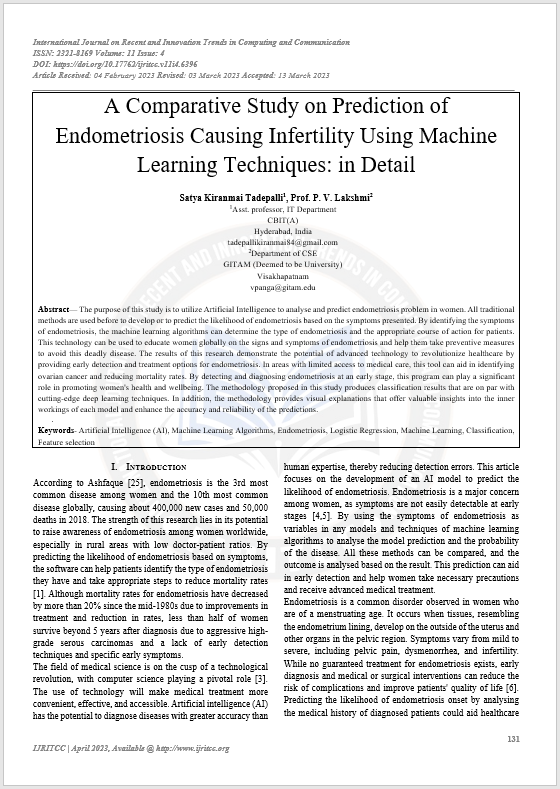A Comparative Study on Prediction of Endometriosis Causing Infertility Using Machine Learning Techniques: in Detail
Main Article Content
Abstract
The purpose of this study is to utilize Artificial Intelligence to analyse and predict endometriosis problem in women. All traditional methods are used before to develop or to predict the likelihood of endometriosis based on the symptoms presented. By identifying the symptoms of endometriosis, the machine learning algorithms can determine the type of endometriosis and the appropriate course of action for patients. This technology can be used to educate women globally on the signs and symptoms of endometriosis and help them take preventive measures to avoid this deadly disease. The results of this research demonstrate the potential of advanced technology to revolutionize healthcare by providing early detection and treatment options for endometriosis. In areas with limited access to medical care, this tool can aid in identifying ovarian cancer and reducing mortality rates. By detecting and diagnosing endometriosis at an early stage, this program can play a significant role in promoting women's health and wellbeing. The methodology proposed in this study produces classification results that are on par with cutting-edge deep learning techniques. In addition, the methodology provides visual explanations that offer valuable insights into the inner workings of each model and enhance the accuracy and reliability of the predictions.
Article Details
References
Marzyeh Ghassemi, Tristan Naumann, Peter Schulam, Andrew L. Beam, Irene Y. Chen, Rajesh Ranganath. A review of challenges and opportunities in machine learning for health. arXivLabs. 2019 v4, https://arxiv.org/abs/1806.00388
Varun H Buch, Irfan Ahmed, Mahiben Maruthappu. Artificial intelligence in medicine: current trends and future possibilities. British Journal of General Practice 2018; 68 (668): 143-144. DOI: https://doi.org/10.3399/bjgp18X695213
Alvin Rajkomar, Sneha Lingam, Andrew G. Taylor, Michael Blum, John Mongan. High-throughput classification of radiographs using deep convolutional neural networks. Journal of Digital Imaging 30, 95–101(2016). DOI: https://doi.org/10.1007/s10278-016-9914-9
Min Chen, Yixue Hao, Kai Hwang, Lu Wang, Lin Wang. Disease prediction by machine learning over big data from healthcare communities. IEEE, 2169-3536 (2017), DOI: https://doi.org/10.1109/ACCESS.2017.2694446
Adriana Gabriela Alexandru, Irina-Miruna Radu, Madalina - Lavinia Bizon. Big data in healthcare - opportunities and challenges. Informatica Economic? vol.22, no. 2/2018. DOI: https://doi.org/10.12948/issn14531305/22.2.2018.05
Iroju Olaronke, Ojerinde Oluwaseun. Big data in healthcare: Prospects, challenges and resolutions. IEEE, 16602629, 2016. DOI: https://doi.org/10.1109/FTC.2016.7821747
Kiranmai, T. S., & Lakshmi, P. V. (2021). 3D Convolution Neural Network Based Ensemble Model to Detect Endometrium Issues at Early Stages and Enhance Fertility Chances in Women. Des. Eng, 1032-1044.
Seidman, J. D., Horkayne-Szakaly, I., Haiba, M., Boice, C. R., Kurman, R. J., & Ronnett, B. M. (2004). The histologic type and stage distribution of ovarian carcinomas of surface epithelial origin. International journal of gynecological pathology, 23(1), 41-44.
Kiranmai, T. S., & Lakshmi, P. V. (2021). A Comprehensive and Systematic Literature Review of Computational Intelligence Algorithms to Diagnose and Predict Female Infertility. Annals of the Romanian Society for Cell Biology, 5926-5943.
S. Pathan, K. Gopalakrishna Prabhu, and P. C. Siddalingaswamy. "Automated detection of melanocytes related pigmented endometrium lesions: A clinical framework." Biomedical Signal Processing and Control 51 (2019): 59-72.
Litjens, G.; Kooi, T.; Bejnordi, B.E.; Setio, A.A.A.; Ciompi, F.; Ghafoorian, M.; Van Der Laak, J.A.; Van Ginneken, B.; Sánchez, C.I. A survey on deep learning in medical image analysis. Med. Image Anal. 2017, 42, 60–88. [CrossRef]
[18] Doupe P, Faghmous J, Basu S. Machine learning for health services researchers. Value Health. 2019;22(7):808-815. Available from: https://pubmed.ncbi.nlm.nih.gov/31277828/ [Accessed: October 1, 2020]
Crown WH. Potential application of machine learning in health outcomes research and some statistical cautions. International Society for Pharmacoeconomics and Outcomes Research (ISPOR). 2015. DOI: 10.1016/j.jval.2014.12.005 [Accessed: October 1, 2020]
Ghassemi M, Naumann T, Schulam P, Beam AL, Chen IY, Ranganath R. A review of challenges and opportunities in machine learning for health. arXivLabs. 2019. Available from: https://arxiv.org/abs/1806.00388 [Accessed: October 1, 2020]
Buch VH, Ahmed I, Maruthappu M. Artificial intelligence in medicine: Current trends and future possibilities. British Journal of General Practice. 2018;68(668):143-144. DOI: 10.3399/bjgp18X695213 [Accessed: October 1, 2020]
Rajkomar A, Lingam S, Taylor AG, Blum M, Mongan J. High-throughput classification of radiographs using deep convolutional neural networks. Journal of Digital Imaging. 2016;30:95-101. DOI: 10.1007/s10278-016-9914-9
Kiranmai, T. S., & Lakshmi, P. V. A Novel Whale Optimized TGVFCMS Segmentation With Modified LSTM Classification For Endometrium Cancer Prediction.
Das, S., Sanyal, M. K., & Datta, D. (2018). Advanced diagnosis of deadly diseases using regression and neural network. In Social Transformation–Digital Way: 52nd Annual Convention of the Computer Society of India, CSI 2017, Kolkata, India, January 19-21, 2018, Revised Selected Papers 52 (pp. 330-351). Springer Singapore.
Tadepalli, S. K., & Lakshmi, P. V. (2021). Deep Learning in IVF to Predict the Embryo Infertility from Blastocyst Images. In ICCCE 2020: Proceedings of the 3rd International Conference on Communications and Cyber Physical Engineering (pp. 1507-1515). Springer Singapore.
Tadepalli, S. K., & Lakshmi, P. V. (2019). Application of Machine Learning and Artificial Intelligence Techniques for IVF Analysis and Prediction. International Journal of Big Data and Analytics in Healthcare (IJBDAH), 4(2), 21-33.
Das, S., & Sanyal, M. K. (2020). Application of AI and soft computing in healthcare: a review and speculation. vol, 8, 21.
Das, S., Biswas, S., Paul, A., & Dey, A. (2018). AI Doctor: An intelligent approach for medical diagnosis. In Industry Interactive Innovations in Science, Engineering and Technology: Proceedings of the International Conference, I3SET 2016 (pp. 173-183). Springer Singapore.
Das, S., Sanyal, M., Datta, D., & Biswas, A. (2018). AISLDr: artificial intelligent self-learning doctor. In Intelligent Engineering Informatics: Proceedings of the 6th International Conference on FICTA (pp. 79-90). Springer Singapore.
Ashfaque, J.M. (2021). Ovary Cancer Data. https://kaggle.com/ukveteran/ovary -cancer -data

